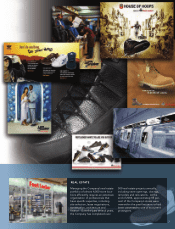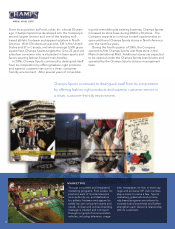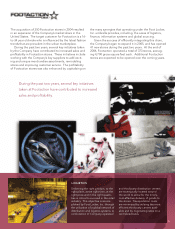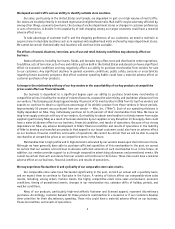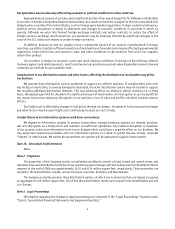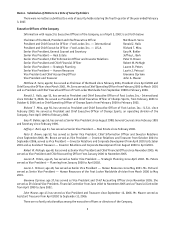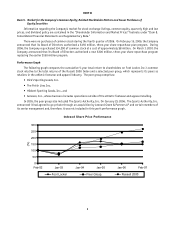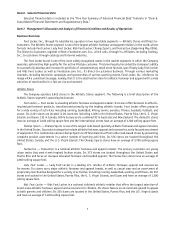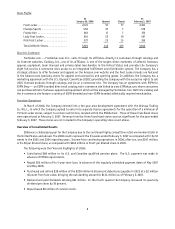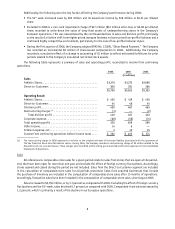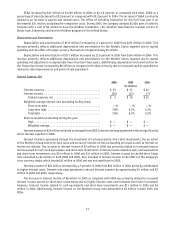Foot Locker 2006 Annual Report Download - page 19
Download and view the complete annual report
Please find page 19 of the 2006 Foot Locker annual report below. You can navigate through the pages in the report by either clicking on the pages listed below, or by using the keyword search tool below to find specific information within the annual report.3
We depend on mall traffic and our ability to identify suitable store locations.
Our sales, particularly in the United States and Canada, are dependent in part on a high volume of mall traffic.
Our stores are located primarily in enclosed regional and neighborhood malls. Mall traffic may be adversely affected by,
among other things, economic downturns, the closing of anchor department stores or changes in customer preferences
or acts of terrorism. A decline in the popularity of mall shopping among our target customers could have a material
adverse effect on us.
To take advantage of customer traffic and the shopping preferences of our customers, we need to maintain or
acquire stores in desirable locations such as in regional and neighborhood malls anchored by major department stores.
We cannot be certain that desirable mall locations will continue to be available.
The effects of natural disasters, terrorism, acts of war and retail industry conditions may adversely affect our
business.
Natural disasters, including hurricanes, floods, and tornados may affect store and distribution center operations.
In addition, acts of terrorism, acts of war, and military action both in the United States and abroad can have a significant
effect on economic conditions and may negatively affect our ability to purchase merchandise from vendors for sale
to our customers. Any significant declines in general economic conditions, public safety concerns or uncertainties
regarding future economic prospects that affect customer spending habits could have a material adverse effect on
customer purchases of our products.
A change in the relationship with any of our key vendors or the unavailability of our key products at competitive
prices could affect our financial health.
Our business is dependent to a significant degree upon our ability to purchase brand-name merchandise at
competitive prices, including the receipt of volume discounts, cooperative advertising, and markdown allowances from
our vendors. The Company purchased approximately 78 percent of its merchandise in 2006 from its top five vendors and
expects to continue to obtain a significant percentage of its athletic product from these vendors in future periods.
Approximately 50 percent was purchased from one vendor — Nike, Inc. (“Nike”). Each of our operating divisions is
highly dependent on Nike, they individually purchase 40 to 65 percent of their merchandise from Nike. We have no
long-term supply contracts with any of our vendors. Our inability to obtain merchandise in a timely manner from major
suppliers (particularly Nike) as a result of business decisions by our suppliers or any disruption in the supply chain could
have a material adverse effect on our business, financial condition, and results of operations. Because of our strong
dependence on Nike, any adverse development in Nike’s financial condition and results of operations or the inability
of Nike to develop and manufacture products that appeal to our target customers could also have an adverse effect
on our business, financial condition, and results of operations. We cannot be certain that we will be able to acquire
merchandise at competitive prices or on competitive terms in the future.
Merchandise that is high profile and in high demand is allocated by our vendors based upon their internal criteria.
Although we have generally been able to purchase sufficient quantities of this merchandise in the past, we cannot
be certain that our vendors will continue to allocate sufficient amounts of such merchandise to us in the future. In
addition, our vendors provide support to us through cooperative advertising allowances and promotional events. We
cannot be certain that such assistance from our vendors will continue in the future. These risks could have a material
adverse effect on our business, financial condition, and results of operations.
We may experience fluctuations in and cyclicality of our comparable store sales results.
Our comparable-store sales have fluctuated significantly in the past, on both an annual and a quarterly basis,
and we expect them to continue to fluctuate in the future. A variety of factors affect our comparable-store sales
results, including, among others, fashion trends, the highly competitive retail store sales environment, economic
conditions, timing of promotional events, changes in our merchandise mix, calendar shifts of holiday periods, and
weather conditions.
Many of our products, particularly high-end athletic footwear and licensed apparel, represent discretionary
purchases. Accordingly, customer demand for these products could decline in a recession or if our customers develop
other priorities for their discretionary spending. These risks could have a material adverse effect on our business,
financial condition, and results of operations.


